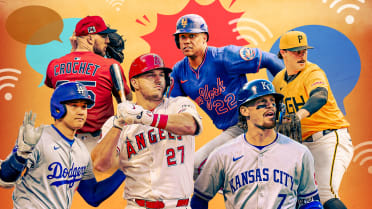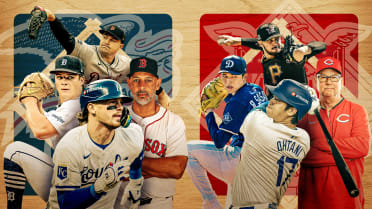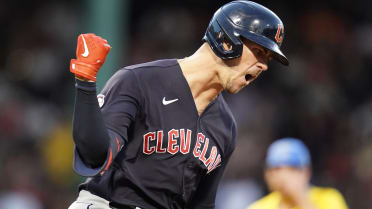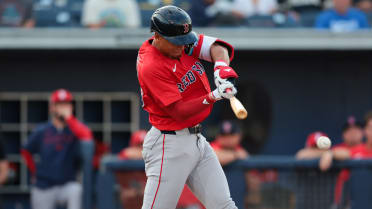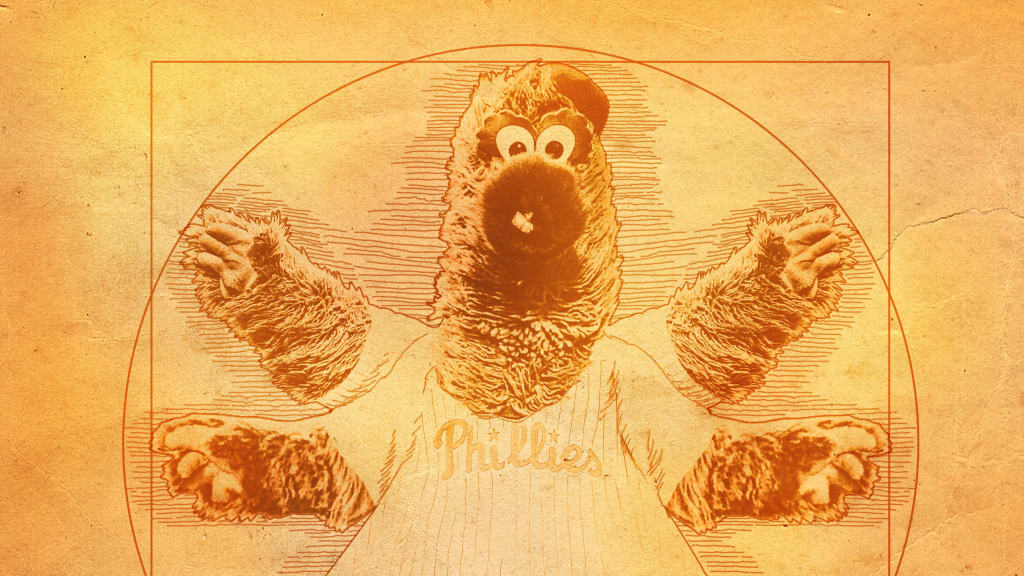
Fans may have disagreements about their team's players or decision makers, but they all agree on one thing: Their mascot is one of the most lovable and entertaining creatures they've ever seen. Yet, it's likely that few fans could say what, exactly, their favorite furry ballpark friend is and how it came into existence.
Behind every mascot lies a story. There's someone who designed it. There's a reason, for instance, someone decided a rotund furry green monster with a weird nose would come to represent the city of Philadelphia. Some mascots even have fictional life stories.
If you've ever looked at a mascot and wondered, "What the heck is that thing?" or "Who on earth came up with that?" here are your answers.
Angels -- Rally Monkey
The Angels are one of three teams -- along with the Dodgers and Yankees -- who don't have an official mascot, but the Rally Monkey has all the power of a good mascot.
The monkey as a mascot was born in June 2000 when the Angels were hosting the Giants. With the team trailing in the ninth inning, the videoboard operators played a clip of a jumping primate from "Ace Ventura: Pet Detective" with the phrase "Rally Monkey" placed on top. The Angels scored two runs and won the game.
The Rally Monkey really took off during the Angels' World Series run in 2002, when it helped power an epic comeback from 5-0 down in Game 6 against the Giants, the very team that witnessed the birth of the talisman three years prior.
Astros -- Orbit
In the late 70's and throughout the 80's the Astros were represented by Chester Charge -- a soldier of the Texas cavalry riding a horse (all in a single costume). But before the start of the 1990 season, the team saw the design and introduction of a new mascot as a way to reach out to the Houston community. Therefore, they assigned the task to the area's best and brightest: its elementary school students.
Over 10,000 children submitted designs for Orbit -- named as an homage to the Houston area's ties to NASA -- and in the ultimate act of "everyone's a winner," the final design was a composite of all 10,000 entries.
Orbit was replaced by a rabbit called Junction Jack in 2000, but he wasn't forgotten. After years of petitions from fans, the Astros brought Orbit back in 2013. He's terrorized visiting players ever since.
A's -- Stomper
The idea behind Stomper goes back to the beginning of the 20th century when the team still played in Philadelphia. After a group of Philadelphia industrialists bought the team, Giants manager John McGraw referred to the A's as "white elephants" -- a term for a burdensome, extravagant gift that's hard to get rid of. It is said to trace back to the King of Siam, who would give albino elephants to those who displeased him. While an elephant would seem like a generous gift, the cost of upkeep was often steep enough to financially ruin those he gave them to.
Manager Connie Mack reappropriated the term into a rallying cry and good luck charm for the team, becoming the de facto logo for the A's along the way. It wasn't until 1997 that the A's introduced the lovable elephant that entertains fans today.
Blue Jays -- Ace
It would be tempting to take one look at Ace -- a blue jay representing the Blue Jays -- and move on. But, Ace is more than just a person in a bird suit -- he's a man (bird) with a family and personality. When he was introduced, he came with a flirty and winking partner, Diamond. His personality was designed after Jim Carrey and she was Goldie Hawn, allegedly because they both possessed "a wild and zany side."
Diamond wasn't long for the mascot world, as she was retired prior to the 2004 season. After operating by himself for a few years, fans were introduced to his younger brother, Junior, who occasionally appears alongside the Jim Carrey-as-bird.
Braves -- Blooper
We'll be honest: We don't know what the heck Blooper is supposed to be either. He's the old carpet from your grandparents' living room wrapped around a vaguely-human shell. Carl Linnaeus would have no idea what to do with him.
Blooper was introduced as a lab creation, with a mad scientist adding mascot-appropriate personality traits -- likes the Braves, is fuzzy, makes jokes -- to a machine. This is what popped out:
Brewers -- Bernie Brewer
Before Bernie Brewer was a cartoonish and mustaschioed man with a giant slide in the outfield, he was actually a real person. The team was struggling to draw fans in its inaugural 1970 season, but retired aviation engineer -- and huge Brewers fan -- Milt Mason had an idea: He would live on top of the stadium's scoreboard until the team drew a crowd of 40,000 fans.
For being on top of a ballpark scoreboard, his setup was pretty sweet. He had a trailer with a refrigerator, a stove, a TV and an exercise bike. He remained in his makeshift abode for 40 days until a promotional bat giveaway brought 44,000 to the park. To celebrate the team's victory on that day, he swung down from his perch on a rope -- leading to rope burn and some broken bones.
He was commemorated in Bernie Brewer, who became the team's mascot in 1973 after Milton's death. He was retired in 1984, but was brought back by popular demand in '93.
Cardinals -- Fredbird
There's not much to explain about Fredbird. As a humanoid cardinal, he's a fitting mascot for the St. Louis Cardinals. His name, Fredbird, is simply a play on "redbird" with a slightly more human flavor.
Some would say the beauty of Fredbird is in his simplicity. He's been around since 1979, making him one of the oldest mascots in the game.
Cubs -- Clark
Clark the Cub is a Cub who likes the Cubs -- a baseball team that plays its home games on Clark Street. Given the age of the franchise, you might think Clark has been around for a while. In fact, he became the first official mascot in team history in 2014.
The team created an origin story for Clark. He's a descendant of Joa -- the team's live bear mascot in 1916 who lived in a cage outside the park -- who escaped the Lincoln Park Zoo and followed the roar of the crowd to Wrigley Field.
Besides that bit of fiction, he's a bear in a Cubs jersey that rocks a backwards cap. Pretty simple.
D-backs -- D. Baxter the Bobcat
Wait. Why isn't the D-backs' mascot just a giant snake? While going with a bobcat as a mascot for a team named after a snake may seem odd at first, it actually makes a surprising amount of sense.
Baxter made his debut in 2000, but he was conceived by Brantley Bell, son of D-backs infielder Jay Bell. The name D. Baxter obviously comes from the team nickname. But why a bobcat? At the time, Chase Field was called Bank One Ballpark, or BOB for short. As it happens, bobcats are also native to Arizona, so the choice of animal works on a couple levels.
Dodgers -- Weary Willie
While the Dodgers have never had an official mascot, they were represented in the minds of fans by a newspaper cartoon character during the 1930s. At that time, the Dodgers were lovable losers and their fans referred to them as "Dem Bums" in an oddly endearing way. Cartoonist Willard Mullin began drawing the "Brooklyn Bum," stylized with an exaggerated Brooklyn accent, to symbolize the team.
But the connection didn't stop there. Circus clown Emmett Kelly, who had created a hobo clown called "Weary Willie," occasionally showed up at Ebbets Field to serve as the team's unofficial mascot.
Giants -- Lou Seal
The result of a fan naming contest, Lou Seal is a tribute to the San Francisco Seals, a Minor League team in the Pacific Coast League from 1903 until 1957. Their name, in turn, is a reference to the harbor seals that reside in the Bay Area year round.
Lou Seal's full name is Luigi Francisco Seal, for some reason.
Indians -- Slider
Slider was created in 1990 after team Vice President Dennis Lehman suggested the team get itself a mascot inspired by the Phillie Phanatic. From the jiggling belly to the elongated snout, the similarities are readily apparent.
The team has been cagey about classifying Slider in the animal kingdom, claiming the mascot is more powerful if fans can use their imaginations for what he is. However, given that it was recently revealed that the Phanatic is a bird, it is probably safe to say that Slider is also a bird, at least biologically.
Mariners -- Mariner Moose
After receiving more than 10,000 suggestions for a new mascot prior to the 1990 season, Mariner Moose squared off with a sea monster -- presumably a resident of the Puget Sound -- in a statewide vote. The moose won.
Mariner Moose was originally suggested by a fifth grader in Bellingham, Wash., named Ammon Spiller. Both he and his elementary school received $1,000 prizes for helping the team find a mascot.
Marlins -- Billy the Marlin
Billy the Marlin has been with the team since its inaugural season in 1993. The Marlins were almost called the Flamingos, which would have meant we would have never gotten Billy.
Team owner Wayne Huizenga didn't want a baseball-centric name for his mascot -- think: Slider, Sluggerrr, etc. -- and wanted something kids could easily remember. A Marlin is a type of billfish, so Billy became the easy-to-remember name of his team's mascot.
Mets -- Mr. Met
Mr. Met first appeared in 1963 as a cartoon drawing in programs. When the team moved to Shea Stadium the following year, he came to life in the form of a costumed mascot -- it's believed he was the first mascot to appear in human form in Major League Baseball.
In print form, Mr. Met was often depicted with a family consisting of himself, Mrs. Met and three "little Mets." Mrs. Met was first introduced as a costumed mascot in 1975.
Nationals -- Screech
A mascot of the people, by the people and for the people, Screech was the result of a fan contest to name and pick a mascot for D.C.'s new baseball team in 2005. The winning idea came from fourth grader Glenda Gutierrez, who claimed that Screech is strong and will eat almost anything. He was hatched -- no, he was actually introduced when he emerged from an egg in the outfield -- later that season.
The bald eagle isn't a new mascot for the nation's capital -- both the Capitals of the NHL and MLS's D.C. United also have the national bird for their mascots.
Orioles -- The Oriole Bird
The Oriole is the state bird of Maryland and also, obviously, lends its name to Baltimore's baseball team. Before he received a physical body, the Oriole was featured on the team's caps beginning in 1966. The costumed mascot Oriole Bird was -- like Screech -- hatched out of a giant egg at the team's 1979 home opener.
Padres -- Swinging Friar
The Friar actually existed before the Major League team he has come to represent. In 1961, the Padres of the Pacific Coast League did what just about every team looking for a mascot does -- they held a fan contest to design an official mascot. A Seaman Apprentice named Carlos Hadaway heard about the contest from a superior. After coming up with a few different designs, the superior submitted two of his favorites to the Padres. The Padres adopted one of his designs and the team kept it after joining the Majors.
Years later, Hadaway would actually begin a career as a professional artist. He has done prints for Budweiser and some of his art inspired by the American West has hung in the Arizona State Capitol.
Phillies -- Phillie Phanatic
Any team can have a fan contest to pick a mascot, but if you want something done right, you have to bring in the professionals. At least, that's what the Phillies thought when they were in the market for a mascot after the 1977 season.
They reached out to Muppets creator Jim Henson and got a design from two people who worked with him -- Bonnie Erickson and Wayde Harrison, who had also created Miss Piggy.
At first, the Phillies weren't sold on the chubby green thing they came up with but figured they'd give it a go for a time. So, they leased the design for years without purchasing the copyright. They could have purchased it for $5,200. Three years later, they spent $500,000 for it. Their initial skepticism was clearly misplaced as the Phanatic has withstood the test of time as one of the most beloved mascots in the history of sports.
Also, the Phanatic is a bird. (Don't ask us why or how.)
Pirates -- Pirate Parrot
The Pirates took notice of the success the Phillies had with the Phanatic in '78 and decided they needed to get in on the action themselves.
Inspired by Long John Silver's companion in "Treasure Island" and modeled off the San Diego Chicken, the Pirate Parrot was thinner and angrier than the current iteration. After the original Pirate Parrot was fired for drug use and distribution, the team moved to a fatter, goofier and more colorful version of the mascot in an effort to appeal to kids and put the controversy behind them.
Rangers -- Rangers Captain
Inspired by the Texas Ranger Division -- a statewide law enforcement agency -- and the image of old Western cowboys, the leader of the Rangers is called the Captain. He's a palomino horse, which was a common color among Western movie stars, most notably Roy Rogers.
A lot of mascots wear No. 0, mostly to avoid the potential for coming into conflict with a player's desired number. Rangers Captain wears No. 72, to commemorate the team moving from Washington, D.C., to Texas in 1972.
Rays -- Raymond
Raymond has been the Rays' mascot since their inaugural season in 1998. But, what's his deal? According to the team, Raymond is a seadog native to the Gulf of Mexico, known scientifically as Canus Manta Whatthefluffalus. Apparently, his fuzzy bearded face resembles that of a walrus and his large belly evokes the image of a manatee.
Reds -- Mr. Redlegs
The Reds have two very similar humanoid mascots with giant baseball heads -- a clean-shaven Mr. Red and a mustachioed Mr. Redlegs. They both can trace their origins to the anti-Communist Red Scare of the 1950s.
In 1953, the team announced that it wanted to be known as the Redlegs, to distance itself from the Communist "Reds." The invention of Mr. Redlegs was part of that effort. The original design had the mascot wearing a jersey of the Red Stockings -- the first professional baseball team.
The first live Mr. Red took the field in 1973, but was replaced by owner Marge Schott's dogs in the late 80's. The clean-shaven Mr. Red made his return in 1997 and was replaced by the mustachioed version in 2007. Clean-shaven Mr. Red returned in 2012 and the two have existed in perfect, vaguely anti-communist harmony ever since.
Red Sox -- Wally the Green Monster
The story of Wally lies entirely in his name. He's a green monster named after the Green Monster -- the giant wall that occupies left field of Fenway Park. Red Sox legend has it that Wally has resided in the wall since 1947 and lived a hermit-like existence for 50 years.
When he was introduced to fans in 1997 he was greeted with a stadium full of booing fans. He has since become a beloved figure among Red Sox fans, due in part to broadcaster Jerry Remy's advocacy. A stuffed animal version of Wally sits in the broadcast booth during every game and Remy has written a series of children's books with (fictional) stories from his life.
Rockies -- Dinger
Why does a team named after a mountain range have a pre-historic animal as its mascot? There have been a number of dinosaur discoveries in the Denver area, for one thing. But the true inspiration for dinger goes back to the construction of Coors Field, when digging crews unearthed some fossils. It wasn't anything too impressive -- they're all housed in a box just large enough to hold a watch -- but it was enough to inspire a dinosaur mascot.
During the first month of the team's second season in 1994, the Rockies announced the discovery of a "dinosaur egg" during construction of their new ballpark and had the National Guard carry the giant "dinosaur egg" into Mile High Stadium to the tune of "Wild Thing." Out popped Dinger.
Royals -- Sluggerrr
Lions are the royalty of the jungle, so it's fitting that the Royals would have a crowned lion for their mascot. While other mascot baseball names like Dinger and Slider don't seem to be physically embodied in the mascot, Sluggerrr appears to be quite muscular and capable of slugging the ball a long way if he gets a hold of one.
Tigers -- Paws
It probably comes as little surprise that the Tigers' mascot is an anthropomorphic Tiger. So, the question naturally becomes: What does Detroit have to do with Tigers? It's true that tigers don't roam the streets of the Motor City, but there are a couple plausible explanations for the name. One suggests that the team was called the Tigers for its habit of wearing orange and black striped stockings. The more plausible explanation is that the name is an homage to the Detroit Light Guard of the Civil War, who was likened to tigers for the ferocity with which it fought.
Paws changes his uniform number every season -- wearing No. 96 in 1996, for example -- but reverts to 00 in years that would conflict with a retired number.
Twins -- T.C. Bear
In 1980 and 1981, the Twins had a bird mascot called Twinkie the Loon and it was truly terrifying to behold. Probably scared away from the very idea of mascots as a result, the team went without a mascot until 2000, when T.C. Bear showed up.
The "T.C." stands for the Twin Cities of Minneapolis and St. Paul. But, why is he a bear?
Hamm's was an early sponsor of the team, and T.C. is said to be loosely based off the bear used in their ads.
White Sox -- Southpaw
There seems to be a tradition among teams to fit some taxonomy onto their furry blobs of mascots. The Phanatic is a bird, somehow. Raymond is a sea dog. The White Sox have not bothered with that -- he's "just a big fuzzy green dude," according to the team's website.
His name is inspired both by the term for a left-handed pitcher -- southpaw -- and the fact that the White Sox play their home games on the South Side of Chicago.
Yankees -- Dandy
The Yankees don't have an official mascot, but that wasn't always the case. After seeing the success the Phillies had with the Phanatic, they reached out to the company that designed him and commissioned a furry, lovable creature of their own.
Instead, they got a Phanatic-looking pinstriped dude with wild orange hair and a mustache called Dandy. He didn't last long as the team's mascot and it's not exactly a mystery why.
Eric Chesterton is a writer for MLB.com. He is an appreciator of the stolen base, the bunt against the shift and nearly every unconventional uniform design. He eagerly awaits Jamie Moyer's inevitable comeback.

